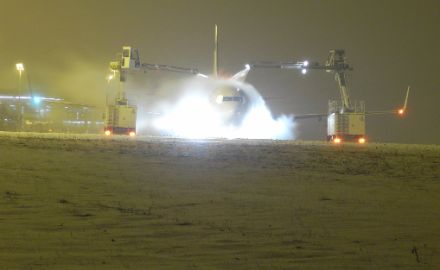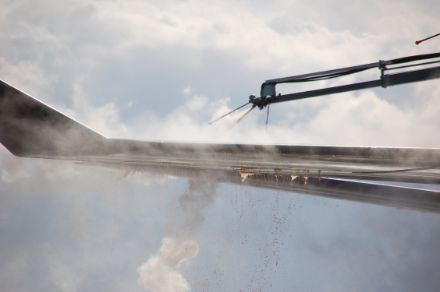Service Navigation
Search

Meteorological factors in the formation of icing
Several conditions must be present for aircraft icing to occur.
- Firstly, the temperature must be below freezing. It is generally accepted that icing can occur at temperatures between zero and around -40°C. If the temperature is colder than that, the air is drier, and the requisite moisture is not there for icing to form. Icing is most severe between zero and -20 degrees.
- Furthermore, water is necessary for ice to form. In saturated conditions when temperatures are below zero, water is present in the air in the form of supercooled water droplets. The higher the liquid water content, the greater the risk of icing.
- Updrafts can also have an impact. For instance, in cumulus clouds, water droplets are rapidly carried to higher altitudes with low temperatures, where they intensify the conditions for icing.
- The size of the droplets is also a determinant of icing severity. Simply put, the larger the droplets, the more severe the icing.
- Aircraft characteristics also play a role in addition to the meteorological aspects. These characteristics include the shape of the wings, the speed of the aircraft and the temperature of the airframe, among other factors.
The impacts of icing
If ice accumulates on the airframe or propeller blades, this can have an impact on flight behaviour,
- since ice on the wings changes the aerodynamic shape of the wing and reduces lift.
- The weight of the aircraft is thereby increased and its centre of gravity can shift, meaning the aircraft can no longer be controlled
- Sensors (for measuring speed, temperature or air pressure) on the aircraft can freeze up, and the corresponding indicators and gauges may therefore display incorrect readings, or no readings at all.
- Moving parts of the aircraft, such as control flaps or landing flaps, can become blocked

Forecasts and icing warnings
Zones with icing conditions can be forecast. As the official aviation weather service, MeteoSwiss provides these forecasts to the relevant users. In the event of severe icing, warnings are also issued for the corresponding airspace zones. These warnings are known as SIGMET (SIGnificant METeorological information). The following is an example of a SIGMET bulletin for Swiss airspace concerning severe icing (SEV ICE) – in this case between Flight Levels 120 and 200 (roughly corresponding to the zone between 3,600 and 6,000 m above sea level):
LSAS SIGMET I01 VALID 111303/111700 LSZH- LSAS SWITZERLAND FIR/UIR SEV ICE FCST AT 1303Z WI N4757 E00900 - N4726 E00951 - N4549 E00720 - N4556 E00632 - N4605 E00547 - N4740 E00749 - N4757 E00900 FL120/200 NC FCST AT 1700Z WI N4552 E00612 - N4537 E00743 - N4629 E00830 - N4620 E00927 - N4704 E01031 - N4804 E00910 - N4552 E00612=
De-icing and anti-icing
Pilots will fly around zones with heavy icing, if possible, or at least only fly through them briefly. However, various measures are also taken to prevent the formation of ice (anti-icing) or to remove it (de-icing). Under the relevant conditions, aircraft are therefore treated with de-icing fluid before take-off to remove ice (and snow) or to prevent icing.

Types of ice: clear ice, rime ice and frost
Ice can take various forms. The main ones are:
- Clear ice: Supercooled water droplets striking the front edge of the wing flow backwards along the aircraft surface and then freeze to form a smooth, solid layer of ice.
- Rime ice: When the water droplets are small and temperatures are lower, the water freezes rapidly after striking the aircraft and does not spread far over the surface. Moreover, ice crystals can form on the surface. A porous, whitish layer of ice forms.
- Frost is formed by the resublimation of water vapour on the outer envelope of the aircraft. A white, crystalline ice coating forms. In contrast to the two other types of ice above, this type can also form when flying through cloudless areas. Frost can also very often form on parked aircraft on cloudless nights.